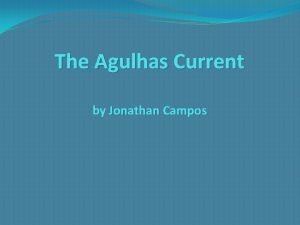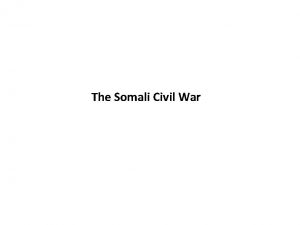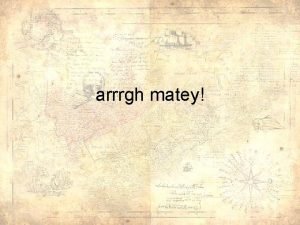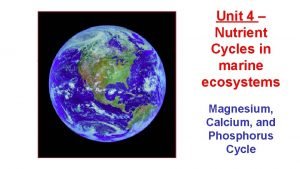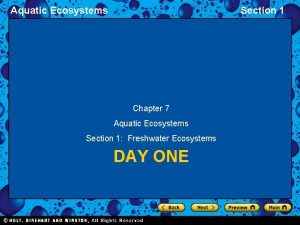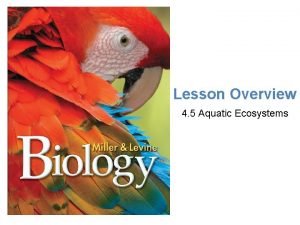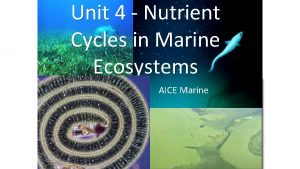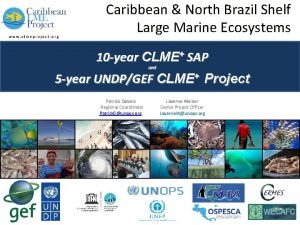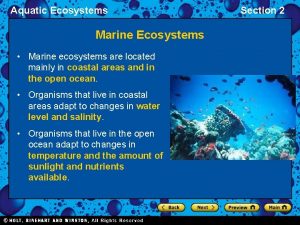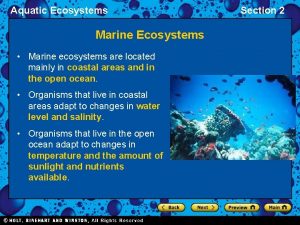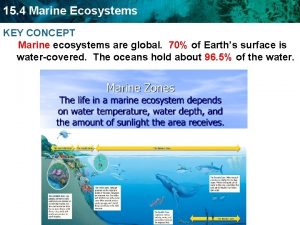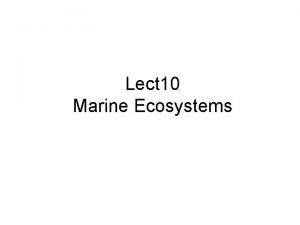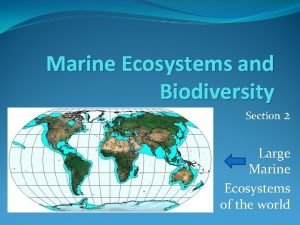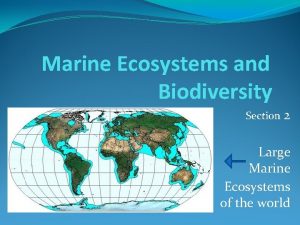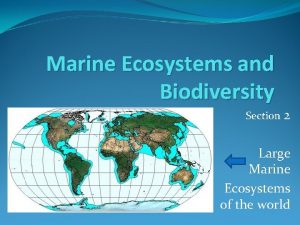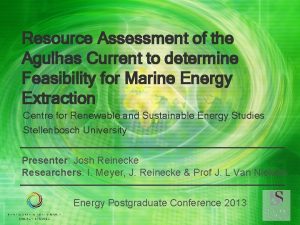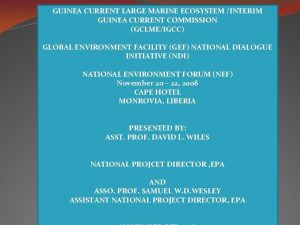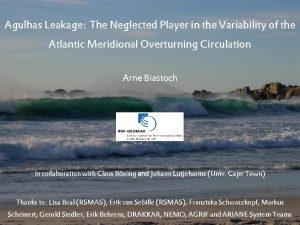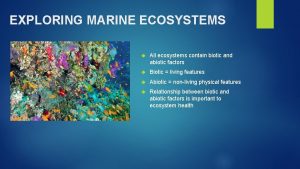The Agulhas and Somali Current Large Marine Ecosystems

















- Slides: 17

The Agulhas and Somali Current Large Marine Ecosystems Project BUILDING AN ECOSYSTEM APPROACH TO MANAGING AFRICAN MARINE RESOURCES Challenges, how we resolved them and what lessons we have learned so far

Agulhas and Somali New Problems with Research Cruise Planning Currents LME Boundaries BUILDING AN ECOSYSTEM APPROACH TO MANAGING AFRICAN MARINE RESOURCES The exact boundaries have yet to be defined Definition is based on bathymetry, currents, productivity, etc. in an attempt to separate out discrete ecosystems for management purposes As the focus is on the ecosystem, the management area will inevitable extend beyond EEZs into ABNJ (high seas) and will be transboundary between sovereign jurisdictions 12°

ASCLME Management & Governance Approach BUILDING AN ECOSYSTEM APPROACH TO MANAGING AFRICAN MARINE RESOURCES There are five important steps which ASCLME is following in terms of evolving effective management and governance at the ecosystem level: 1. The Baseline: Identifying the existing status and boundaries of the LMEs in the Western Indian Ocean region (You cannot manage what you haven’t measured) 2. Impacts and Causes: Agreeing on the main threats to the ecosystem, its living resources and the communities that depend on them and identifying specific areas of concern that need observing 3. Monitoring: Developing an effective monitoring and early warning mechanism for ecosystem variability and climate change, building on the baseline surveys and adopting appropriate indicators of change (You cannot adapt to change unless you can recognise change) 4. Science-to-Governance: Translating the outputs from this monitoring into policy and management level priorities and guidelines for adaptive management and decision-making 5. Cooperative Management: Evolving and adopting a Western Indian Ocean Alliance of partners to achieve sustainability of monitoring and adaptive management within the LMEs using the ecosystem approach

Achievements to date BUILDING AN ECOSYSTEM APPROACH TO MANAGING AFRICAN MARINE RESOURCES A. B. C. D. E. F. G. H. I. A detailed baseline assessment of a previously unknown area. Over 22 coastal and offshore research cruises over 4 years A detailed and comprehensive Marine Ecosystem Diagnostic Analysis completed for each country (including socioeconomics, coastal livelihoods assessment, policy and governance assessment and cost-benefit analysis of an EBM approach. Causal Chain Analyses now being finalised. TDA currently under construction Over 40 Ecosystem Assessment practitioners have been trained 70 plus regional and international ecosystem-related scientific experts directly involved in baseline and monitoring process Over 50 related and peer-reviewed publications gone to ‘Abstract’ of which more than 20 already published Scientific Coordination Expert bodies created in each country to support the Ecosystem management process A strongly evolving WIO Alliance for scientific monitoring and adaptive (dynamic) EBM with over 15 partner organisations formally signed-up and many more cooperating on an informal basis Over $12 million in ‘additional’ co-funding leveraged above the original co-funding figure through partnership agreements

Challenges and Resolutions BUILDING AN ECOSYSTEM APPROACH TO MANAGING AFRICAN MARINE RESOURCES 1. Data-poor region with very little ecosystem information 2. Limited national capacities for data capture and handling 3. Lack of effective country ownership 4. Resistance to any new bureaucracy or governing body 5. Poor Coordination and Interaction across Disciplines and between ‘Players’ 6. Disconnect between Science and Governance 7. Absence of Realistic Community Engagement 8. No Involvement of Private Sector and Industry

1. Data-Poor Region BUILDING AN ECOSYSTEM APPROACH TO MANAGING AFRICAN MARINE RESOURCES Challenge The WIO is one of the least known areas of the world’s oceans in terms of marine science. Therefore, it was essential to undergo a strategically focused and comprehensive data capture period in order to develop an effective baseline which could realistically drive/support a SAP development process Resolution An expansive programme of data capture at the coastal and offshore level to ensure: i) a strong enough understanding of the drivers of oceanclimate interactions and their influence on the LMEs ii) an early insight into the relationship and interactions between the LMEs and their dependent communities and community welfare iii) most importantly to provide a baseline against which

2. Limited National Capacities BUILDING AN ECOSYSTEM APPROACH TO MANAGING AFRICAN MARINE RESOURCES Challenge Limited national capacities for ecosystem-based management and monitoring Resolution There is a high level of capacity within some specialised institutions in the region, particularly in terms of oceanographic, fisheries and general ecosystem management skills. This capacity has and is being captured and put to good use. 2 three-week training courses in the class and at sea on Ecosystem Management and monitoring approaches has resulted in over 40 trained practitioners/scientist and now over 70 regional scientists taking part in the long-term ecosystem monitoring programmes. CB&T programme is being expanded now through a growing arrangement of academic and global institutional partnerships Because of the presence of skilled EBM experts in the region, less than 3%

3. Lack of Effective Country Ownership BUILDING AN ECOSYSTEM APPROACH TO MANAGING AFRICAN MARINE RESOURCES Challenge Delay between the negotiation phase and the actual implementation phase (several years) for the Project. Country ownership of the Project therefore often resided in one or two individuals at best and was not inherent at the institutional level Resolution ASCLME PSC agreed to start the TDA-SAP process with national Marine Ecosystem Diagnostic Analyses (MEDAs). This has proved to be a highly valuable and popular new approach as: i) it required the creation of an in-country nucleus of LME experts which now forms the core of a long-term national technical inter-sectoral group ii) it has created a strong sense of ownership within the countries iii) it provides each country with a baseline ‘State of the Marine Environment’ report from which they can evolve (or amend and update) a National Action Programme. iv) ensures that the TDA and its associated SAP and long-term monitoring programmes are ‘anchored’ at the national level as well as into regional institutions and activities.

4. Resistance to any new bureaucracy or governing body BUILDING AN ECOSYSTEM APPROACH TO MANAGING AFRICAN MARINE RESOURCES Challenge The participating countries and the various Conventions and Commissions operating in the region made it clear that they did NOT want a Commission-style management approach. It was felt that there were already sufficient mandated and responsible organisations and entities and that any attempt to usurp those mandates or to overarch them with a new body would meet strong resistance. Resolution Rather than trying to develop an ungainly and unnecessary overarching new body, ASCLME is working closely with other partners to develop the WIO Alliance. The Alliance is a partnership between the countries, mandated bodies and institutions within the region, and international supportive agencies all working together to develop an effective long-term management programme for the WIO LMEs. The Alliance includes partnerships for undertaking scientific monitoring and research (and delivering the results and conclusions to managers and decisionmakers) and for CB&T.

5. Poor Coordination and Interaction across Disciplines and between ‘Players’ BUILDING AN ECOSYSTEM APPROACH TO MANAGING AFRICAN MARINE RESOURCES Challenge Large interest and funding commitment in this region in terms of oceanclimate interactions and the fact that the region was likely to suffer first and hardest from climate extremes. However, there was little interaction or collaboration across disciplines or with appropriate national institutions. This led to duplication and lack of cost-effectiveness of efforts Resolution ASCLME has attempted to act as a facilitating agency for all of these various activities whilst diplomatically avoiding any impression of formally adopting a coordination role without formal agreements to this effect The Project has also developed a number of ‘Aides-Memoire’ with various institutions and agencies working in the region which define the areas of cooperation between them and the Project The evolving Alliance aims to consolidate these various Aides-Memoire under the overall SAP so that each entity agrees to a clearly defined responsibility within the overall ecosystem management strategy

6. Disconnect between Science and Governance BUILDING AN ECOSYSTEM APPROACH TO MANAGING AFRICAN MARINE RESOURCES Challenge Very little of the science and data analysis so far has been effectively translated into management tools or guidelines or into policy briefings. Science needed to be applied and delivered and adaptive management needed to be driven through identification of trends and monitoring of change Resolution Both the PSC and the Joint (ASCLME/SWIOFP) Policy and Governance Assessment concluded that the WIO needed an effective Science-to. Governance mechanism This mechanism needs to translate the outputs from scientific work (TDA and monitoring) into adaptive management and governance guidelines and briefs to managers and policy-makers. Such ‘Science-Based Governance’ is now being developed at the national and regional level using a ‘Weight-of-Evidence’ approach which takes the science beyond the Precautionary Approach and prioritises those issues that need higher confidence limits

7. Absence of Realistic Community Engagement BUILDING AN ECOSYSTEM APPROACH TO MANAGING AFRICAN MARINE RESOURCES Challenge The original Project Document had a limited amount of focus toward community engagement and coastal emphasis Resolution There are now community engagement demonstrations in each country operating through the concept of DLIST It is hoped that the lessons learned from these and further community engagement practices by Alliance partners will help to develop a more robust and sustainable mechanism for community involvement in the LME management process and in the decisionmaking and policy process The Project deliverables were expanded to include a detailed and comprehensive assessment of coastal livelihoods, coastal habitat mapping and artisanal, small-scale, inshore fisheries

8. No Involvement of Private Sector and Industry BUILDING AN ECOSYSTEM APPROACH TO MANAGING AFRICAN MARINE RESOURCES Challenge There was also little focus on engagement with the Private Sector in the original document. There are many different private ‘sector’ groups that could and should be engaged (oil, gas, shipping, tourism, etc) Resolution Private Sector Engagement is a new and strong focus of ASCLME The Project aims to develop a ‘one-stop shop’ approach by partnering with the World Ocean Council The World Ocean Council and a number of its members have expressed a strong interest in supporting the aims of the Alliance partners both at the monitoring and data capture level but also at the ecosystem management and regulatory level

Lessons Learned and Best Practices - ONE BUILDING AN ECOSYSTEM APPROACH TO MANAGING AFRICAN MARINE RESOURCES A Project of this nature is not ‘written-in-stone’ and should be dynamic (Adaptive Management) One of the first functions of a Manager, PCU and PSC should be to review the original Project Document to identify any short-comings or gaps, and then open discussions between the countries and the Implementing Agency as to how best to resolve these in terms of amendments to activities, deliverables and budget realignments In the case of the ASCLME Project, we hired the original Project Development consultant to come back to the 1 st Steering Committee to review the objectives and Log. Frame and, with hindsight, to present some of the gaps and shortfalls This proved enormously valuable and the Project was able to get the Steering Committee to agree to creating some new activities (Policy and Governance Assessment; Coastal Livelihoods Assessment) and to revise the budget to cover new posts, consultancies and workshops to support these

Lessons Learned and Best Practices - TWO BUILDING AN ECOSYSTEM APPROACH TO MANAGING AFRICAN MARINE RESOURCES A top-down approach can often cause conflict and resentment with the people operating ‘on-the-ground’ Based on recommendations from regional IGOs, the Project developed its Alliance and partnerships approach (along with new management and governance structures) from the bottom upwards (not excluding communities) so as to build support from the grass-roots scientists and the various institutions which have to undertake the management process. This has slowly but surely created a strong support structure. At the same time, the ‘concept’ of an Alliance and new governance mechanisms have been exposed to Directors and Permanent Secretaries so as to give them an awareness of what to expect

Lessons Learned and Best Practices - THREE BUILDING AN ECOSYSTEM APPROACH TO MANAGING AFRICAN MARINE RESOURCES Revising the overall objectives to deliver national MEDAs (Marine Ecosystem Diagnostic Analyses) has proved to be an extremely valuable new exercise as: A. This left each country with a valuable national product prior to the TDA process and from which they could create or refine National Action Programmes B. It has built strong country ownership for the Project C. It has provided an enormous amount of accurate input to the TDA process D. It created in-country teams of experts and specialists that can now form the core of a national inter-sectoral body for monitoring and for putting into effect the new science-togovernance mechanisms as part of the long-term SAP

WITH THANKS… BUILDING AN ECOSYSTEM APPROACH TO MANAGING AFRICAN MARINE RESOURCES …to all of our Partners who have made the ASCLME project a success so far And looking forward to developing further partnerships for a more dynamic adaptive management approach
 Agulhas current
Agulhas current Capital of somali
Capital of somali What do pirates hate
What do pirates hate Marine magnesium cycle
Marine magnesium cycle What two locations are marine ecosystems usually located?
What two locations are marine ecosystems usually located? How do ecologists usually classify marine ecosystems?
How do ecologists usually classify marine ecosystems? Nutrient cycles in marine ecosystems
Nutrient cycles in marine ecosystems Caribbean large marine ecosystem
Caribbean large marine ecosystem Y connected generator
Y connected generator Phase to phase voltage
Phase to phase voltage Energy band diagram of pnp transistor
Energy band diagram of pnp transistor Lesson 4 three-phase motors
Lesson 4 three-phase motors Drift current and diffusion current
Drift current and diffusion current Ceramic composition resistors
Ceramic composition resistors In a ∆-connected source feeding a y-connected load
In a ∆-connected source feeding a y-connected load Holding current and latching current
Holding current and latching current Drift current and diffusion current in semiconductor
Drift current and diffusion current in semiconductor The value of vgs that makes id approximately zero is
The value of vgs that makes id approximately zero is
